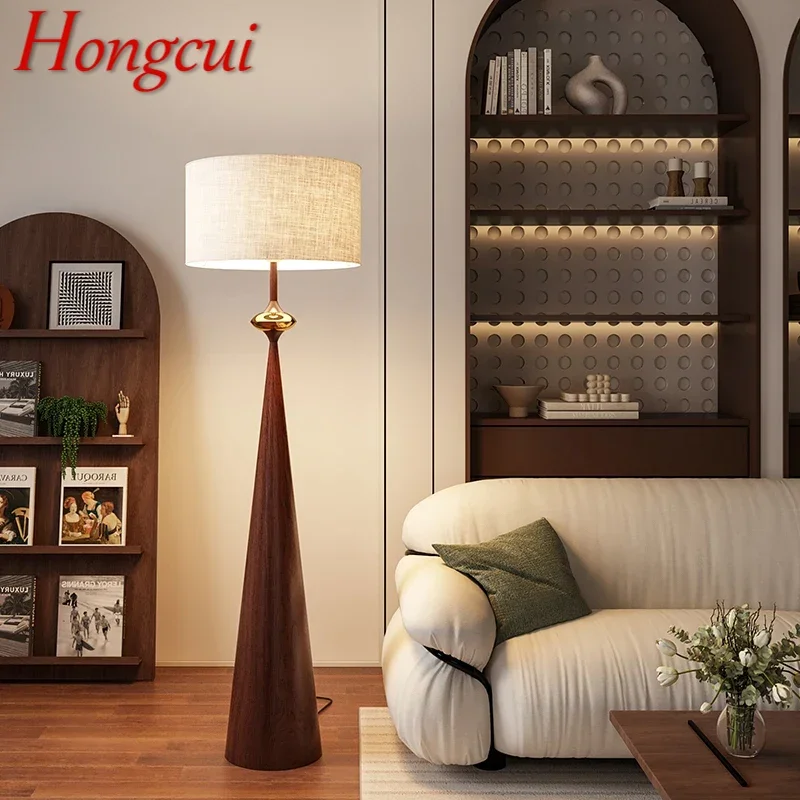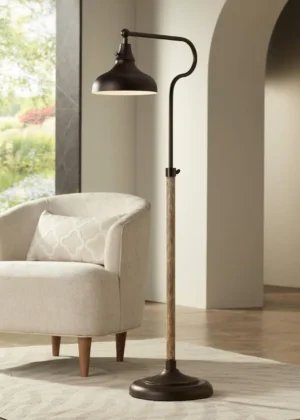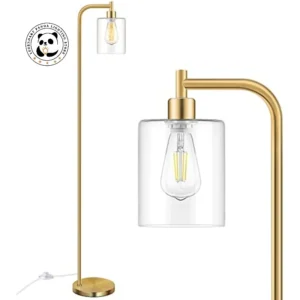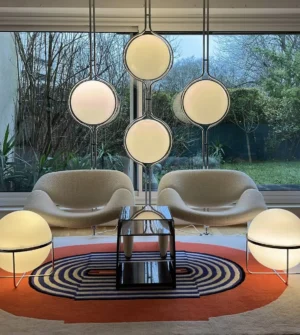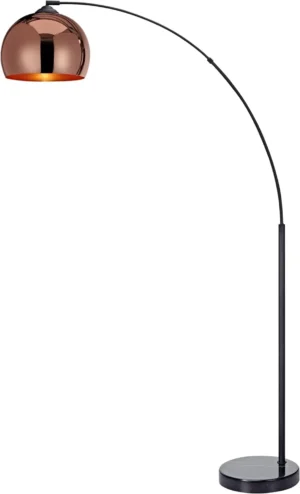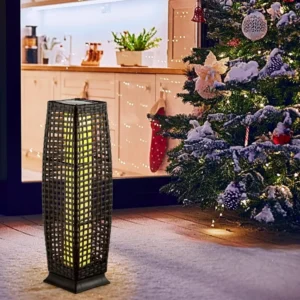Introduction: The Challenge of Illuminating Vertical Space
High ceiling rooms present a unique lighting challenge that many homeowners struggle to overcome. These grand spaces—whether in lofts, great rooms, or converted industrial spaces—often suffer from poor light distribution, creating unwanted shadows and leaving vast amounts of vertical space underutilized. The physics of light means that illumination weakens significantly as it travels from ceiling fixtures to living areas below, resulting in spaces that feel cold and impersonal despite their impressive architecture.
Arc lamps offer a strategic solution to this common dilemma. With their distinctive curved design and adaptable positioning, they bring light precisely where it’s needed while adding visual interest to expansive vertical spaces. However, successfully lighting high-ceiling rooms requires more than simply placing an arc lamp in the corner.
This guide explores both the technical considerations and aesthetic principles of illuminating grand spaces with arc lamps. We’ll examine how proper lighting not only enhances architectural features but also creates functional, welcoming environments within even the most challenging tall rooms.
Understanding High Ceiling Lighting Challenges
Before exploring solutions, let’s understand why high ceilings create lighting complications:
Light Diffusion Physics: Light follows the inverse square law, meaning its intensity diminishes dramatically with distance. In rooms with 10+ foot ceilings, light from standard ceiling fixtures becomes significantly weaker by the time it reaches functional areas.
Shadow Formation: Traditional ceiling-mounted fixtures in tall rooms create harsh shadows and dark corners, particularly along walls and in the middle areas of large rooms.
Scale Imbalance: Standard lighting fixtures often appear disproportionately small in high-ceiling environments, creating visual disconnect and failing to make proper design impact.
Energy Inefficiency: Attempting to light large vertical volumes using only overhead fixtures typically requires high-wattage bulbs, leading to energy waste and increased costs.
Dead Space: Perhaps most problematic is the creation of “dead zones” in the middle height of rooms, where walls receive neither the focused illumination of task lighting nor the wash of ceiling fixtures.
These challenges require specialized approaches that address the unique characteristics of vertical space. Without proper lighting strategies, even the most beautiful high-ceiling rooms can feel uncomfortable and uninviting. Fortunately, best lighting solutions for high ceilings exist, with arc lamps being among the most effective and visually striking options.
Arc Lamps: The Elegant Solution for Vertical Space
Arc lamps feature a distinctive design with a heavy weighted base supporting a curved arm that extends outward and upward, suspending a light source over a specific area. This unique structure allows them to project light across space without requiring ceiling installation—a perfect solution for high-ceiling environments.
Originally designed for grand spaces in mid-century interiors, today’s arc lamps combine historical elegance with modern functionality. Their defining characteristics make them particularly well-suited for tall rooms:
Vertical Presence: Typical arc lamps stand 5-7 feet tall with arcs extending 30-60 inches, allowing them to occupy and define vertical space that would otherwise remain empty.
Flexible Positioning: Unlike fixed ceiling fixtures, arc lamps can be positioned precisely where light is needed most, then adjusted as room layouts or needs change.
Architectural Contribution: The sweeping curves of arc lamps create visual interest within large volumes, adding a sculptural element that complements architectural features.
Adaptable Light Direction: The suspended shade can often be angled to direct light exactly where needed—whether for reading, conversation, or highlighting design elements.
For spaces with particularly high ceilings, specialized tall arc floor lamps for vaulted ceilings offer extended reach and proportional design that maintains visual balance even in extremely vertical spaces.
Why Arc Lamps Excel in High Ceiling Environments
The advantages of arc lamps in tall spaces extend beyond their basic functionality:
Visual Anchoring: Arc lamps create a visual “bridge” between floor and ceiling, connecting these distant elements and making the space feel more cohesive.
No Wiring Requirements: Perfect for rental properties or rooms with concrete ceilings, arc lamps require no electrical modifications while providing the effect of a pendant light.
Zone Definition: In open-concept spaces with high ceilings, arc lamps help define functional areas like reading nooks or conversation spaces without physical barriers.
Proportional Design: The substantial nature of arc lamps stands up to the grandeur of high ceilings, preventing the “miniaturized furniture” effect that often occurs in tall rooms.
Design Statement: Beyond their practical benefits, arc lamps make bold architectural statements that complement contemporary spaces while filling what would otherwise be empty air.
For rooms with especially dramatic heights, large oversized arc floor lamps provide the necessary scale to maintain proportion while delivering powerful illumination.
Design Limitations: When Arc Lamps Need Companions
Despite their advantages, arc lamps rarely serve as complete lighting solutions for high-ceiling rooms:
Limited Coverage Area: Even large arc lamps typically illuminate only 50-80 square feet effectively, creating a “zone” of light rather than comprehensive room illumination.
Directional Nature: Their focused light creates a dramatic effect but may intensify shadows in other areas of the room.
Floor Space Requirements: The substantial base and arching design require adequate floor clearance and thoughtful placement to avoid disrupting traffic flow.
Single-Point Source: As a single light source, arc lamps can’t address all three lighting layers needed in well-designed interiors.
These limitations highlight why arc lamps work best as part of a comprehensive lighting plan. For spaces where flexibility is crucial, adjustable arc floor lamps help overcome some of these constraints through adaptable height and direction features.
The Foundation of Effective High-Ceiling Lighting: Layering
The most successful high-ceiling lighting plans incorporate layered illumination—a fundamental interior design principle that becomes even more crucial in vertically expansive spaces. This approach combines three distinct types of lighting:
Ambient Lighting
This base layer provides general illumination throughout the room. In high-ceiling spaces, ambient lighting often comes from chandeliers, recessed lights, or cove lighting that brightens upper walls and ceilings. Ambient lighting prevents the “dark cave” effect that can make tall rooms feel oppressive.
Task Lighting
This focused illumination serves specific functions like reading, cooking, or working. Arc lamps excel as task lighting, directing bright, controlled light exactly where activities occur without washing out the entire space.
Accent Lighting
This layer highlights architectural features, artwork, or design elements. While typically achieved through wall sconces or directional spotlights, arc lamps can sometimes serve this function when positioned to showcase specific areas.
Arc lamps uniquely bridge task and accent categories, providing functional illumination while creating visual interest. Their contribution to a room’s mastering ambient lighting with arc lamps involves how they interact with other fixtures to create depth, dimension, and proper light distribution at all levels.
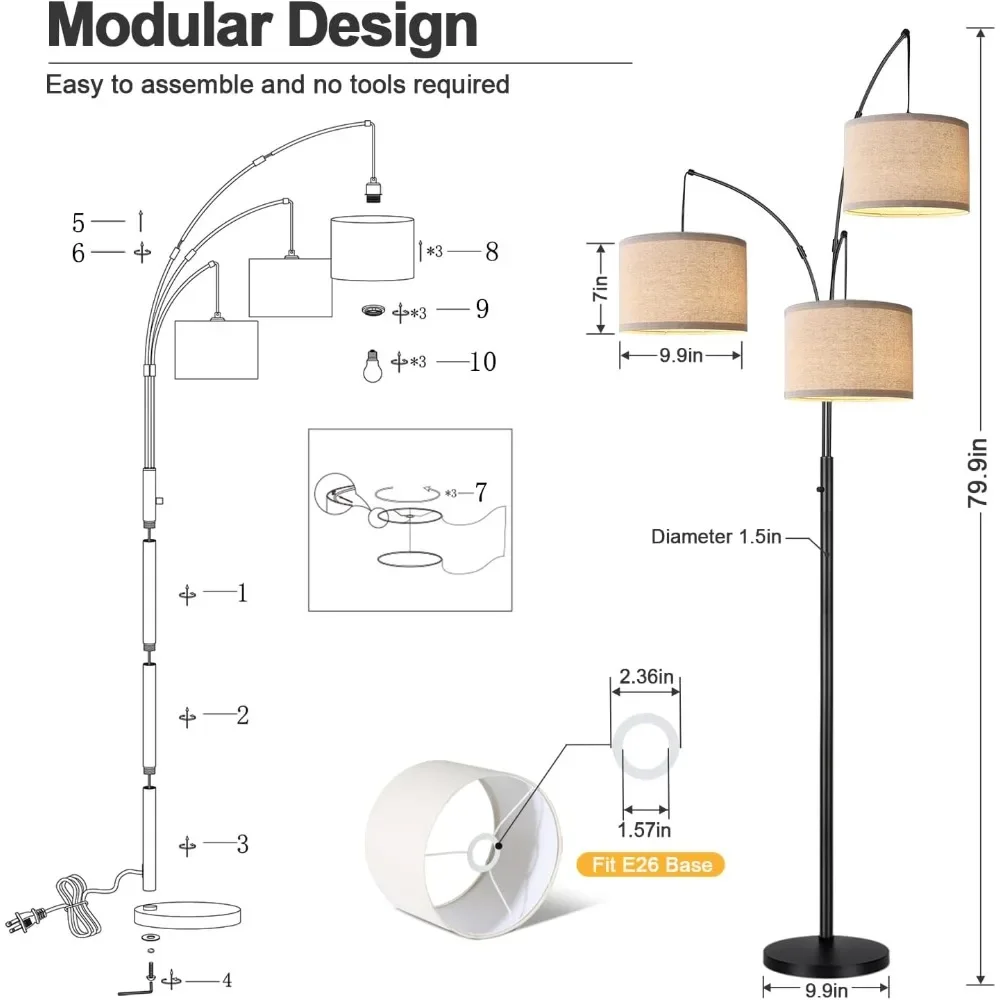
Applying the Rule of Thirds in Tall Room Illumination
The “rule of thirds” concept, borrowed from photography and art, provides a valuable framework for lighting vertical spaces. When applied to high-ceiling rooms, this principle divides the vertical space into three distinct zones, each requiring different lighting approaches:
Upper Third (Ceiling and Upper Walls)
In rooms with 12-20 foot ceilings, this zone typically starts around 8-14 feet from the floor. This area benefits from:
– Uplighting that highlights ceiling texture
– Wall-washing fixtures that prevent the “black hole” ceiling effect
– Chandeliers or pendants that bring light sources into this otherwise neglected space
Middle Third (Mid-Walls and Upper Furniture)
This transitional zone (approximately 4-8 feet from the floor) often receives the least attention in lighting plans but is crucial for visual comfort. This area benefits from:
– Arc lamps that project light across the middle height of the room
– Wall sconces that provide mid-level illumination
– Art lighting that activates wall spaces
Lower Third (Floor and Lower Furniture)
This zone (0-4 feet from the floor) is where most activity occurs and requires the most functional illumination. This area benefits from:
– The downward light from arc lamps
– Table lamps for intimate lighting
– Floor uplights that create dramatic shadows upward
Arc lamps are particularly valuable because they can span multiple zones, with their bases anchored in the lower third, their arcs sweeping through the middle third, and their light often reaching into the upper third. For rooms with exceptional height, oversized arched floor lamps provide the necessary scale to effectively bridge these zones.
Strategic Placement: Positioning Arc Lamps in High Spaces
The impact of an arc lamp depends significantly on its placement within tall rooms. Consider these strategic positioning approaches:
Over Seating Areas: Position arc lamps to extend over sofas, reading chairs, or conversation groupings, keeping the light source approximately 24-30 inches above head height when seated. This creates intimate zones within vast spaces.
Adjacent to Dining Areas: Place arc lamps near dining tables to provide ambient lighting that complements overhead fixtures, ensuring the arc doesn’t interfere with sight lines across the table.
Near Vertical Features: Position arc lamps to illuminate and emphasize tall bookshelves, artwork, or architectural elements like columns or exposed brick walls.
In Transitional Spaces: Use arc lamps to define pathways or transitions between open areas, guiding movement through large rooms.
Balance with Architecture: Place arc lamps to counterbalance architectural features like fireplaces or built-ins, creating visual equilibrium in asymmetrical spaces.
When placing arc lamps, always consider:
– Minimum clearance of 7 feet above walkways
– Stable positioning away from high-traffic areas
– Cable management to prevent tripping hazards
– Visual balance with other large elements in the space
For more specific strategies on maximizing the impact of these distinctive fixtures, explore arc lighting solutions for high spaces.
Selecting the Perfect Arc Lamp for Your Space
Choosing the right arc lamp for high-ceiling environments requires careful consideration of several factors:
Scale and Proportion
– For ceilings 10-12 feet high: Consider arc lamps 60-70 inches tall
– For ceilings 12-14 feet high: Look for arc lamps 70-80 inches tall
– For ceilings 14+ feet high: Seek oversized options 80+ inches tall
Arc Reach and Coverage
– Small rooms: 30-40 inch arc reach
– Medium rooms: 40-50 inch arc reach
– Large rooms: 50-65+ inch arc reach
Base Stability and Weight
– Higher ceilings require lamps with larger, heavier bases to maintain visual proportion
– Marble or substantial metal bases provide necessary stability and visual weight
– Consider floor protection for heavy bases on delicate flooring
Light Output Specifications
– High ceilings typically require fixtures providing at least 800-1200 lumens
– Adjustable brightness through dimmable arc floor lamps offers versatility for different activities and times of day
Adjustability Features
– Height-adjustable models adapt to different ceiling heights
– Direction-adjustable shades provide precise light placement
– Dimming capabilities create ambiance flexibility
Style Compatibility
– Modern spaces: Sleek metallic finishes with minimalist shades
– Industrial spaces: Exposed bulbs or mesh shades with darker finishes
– Traditional spaces: Warmer metals with fabric shades

Complementary Fixtures: Creating a Complete Lighting Ecosystem
Arc lamps work best as part of a comprehensive lighting plan that addresses all zones of high-ceiling rooms. Consider these complementary fixture types:
Overhead Lighting Options
– Chandeliers or pendant clusters that bring light down from high ceilings
– Recessed lighting arranged to provide even ambient illumination
– Track lighting that can be directed to walls and features
Wall-Mounted Companions
– Wall sconces positioned at 5-7 feet high to illuminate mid-level zones
– Picture lights to highlight artwork and add mid-wall brightness
– Wall-washing fixtures that bring attention to textured surfaces
Additional Floor and Table Options
– Table lamps on higher surfaces (console tables, bookshelves) to fill middle zones
– Uplights positioned strategically to illuminate dark corners
– Secondary floor lamps for additional task lighting
When selecting complementary fixtures, maintain consistency in:
– Metal finishes (keep within the same color family)
– Light temperature (typically 2700K-3000K for residential spaces)
– General design language (modern with modern, traditional with traditional)
Understanding how to incorporate arc lamps into these broader schemes enhances their effectiveness, as detailed in guides about flexible lighting with arc lamps.
Adjustable Arc Floor Lamp, Bronze Arc Floor Lamp
Price range: $440.95 through $558.52 Select options This product has multiple variants. The options may be chosen on the product pageBrass Arc Floor Lamp, Contemporary Arc Floor Lamp, LED Arc Floor Lamp
Price range: $490.72 through $522.04 Select options This product has multiple variants. The options may be chosen on the product pageChrome Arc Floor Lamp, LED Arc Floor Lamp
Price range: $304.95 through $1,210.40 Select options This product has multiple variants. The options may be chosen on the product pageContemporary Arc Floor Lamp, Large Arc Floor Lamp, Marble Base Arc Floor Lamp
$224.94 Select options This product has multiple variants. The options may be chosen on the product pageLED Arc Floor Lamp, Rattan Arc Floor Lamp
$313.58 Select options This product has multiple variants. The options may be chosen on the product page- $1,003.85 Select options This product has multiple variants. The options may be chosen on the product page
Technical Considerations for High-Ceiling Arc Lamp Installation
Beyond aesthetics, several technical factors impact the effectiveness of arc lamps in tall spaces:
Light Bulb Selection
– LED options provide energy efficiency crucial for high ceilings where bulb changing is difficult
– For ceilings 10-12 feet: Minimum 800 lumens recommended
– For ceilings 12-15 feet: 1000-1200 lumens recommended
– For ceilings 15+ feet: 1200+ lumens recommended
Color Temperature Choices
– 2700K-3000K creates warm, inviting environments in residential spaces
– 3000K-3500K provides clean, neutral light appropriate for modern interiors
– 4000K+ delivers bright, energizing light suitable for spaces requiring high visibility
Energy Efficiency
– LED arc floor lamps use 75-80% less energy than halogen alternatives
– Consider models with integrated LEDs for longest lifespan
– Look for Energy Star ratings when available
Control Systems
– Dimmers allow customization of light levels for different activities
– Remote controls eliminate the need to access the lamp base for adjustments
– Smart home compatibility enables integration with whole-home lighting scenes
Maintenance Considerations
– Evaluate ease of bulb replacement given the height of the fixture
– Consider dust accumulation on shades in high-ceiling environments
– Check stability features if the space experiences heavy traffic or pets
Creating Visual Impact: Arc Lamps as Statement Pieces
Beyond their functional role, arc lamps serve as sculptural elements that can define a room’s character. Their dramatic silhouettes create visual interest that complements the grandeur of high-ceiling spaces.
When leveraging arc lamps as design statements:
– Position them where their full form can be appreciated, with adequate space around the arc
– Choose finishes that either complement or intentionally contrast with major design elements
– Consider how light and shadow patterns created by the lamp contribute to the room’s atmosphere
– Use the lamp to draw attention to important architectural features or furnishings
The base material significantly impacts the lamp’s presence—marble base arc floor lamps provide substantial visual weight appropriate for very tall spaces, while metal bases with distinctive finishes can complement specific design styles.
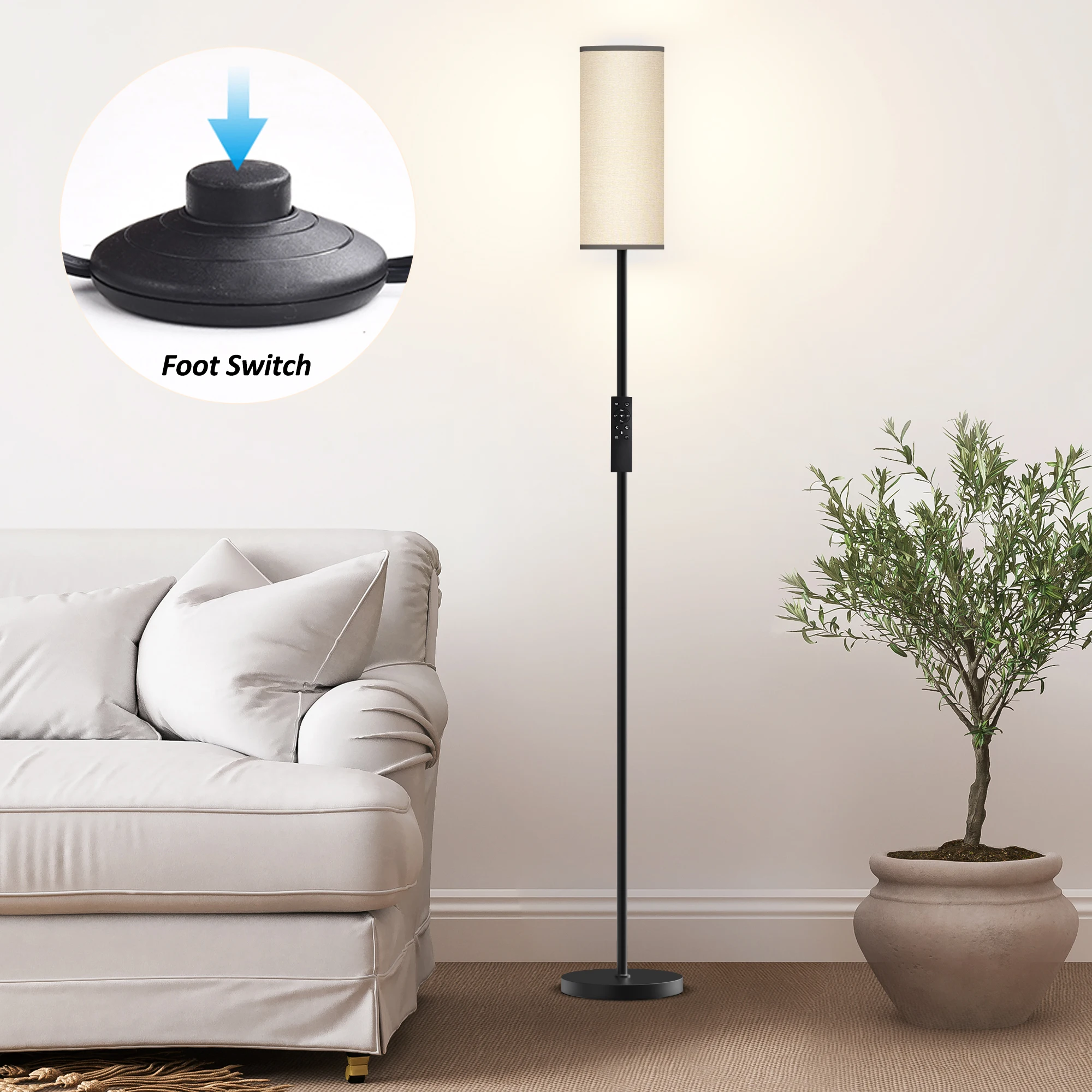
Styling Arc Lamps for Different Interior Design Themes
Different interior styles benefit from specific arc lamp characteristics:
| Design Style | Recommended Arc Lamp Features |
|---|---|
| Modern/Contemporary | Sleek metallic finishes (chrome, brushed nickel), minimalist shades, clean lines, integrated LED technology |
| Industrial Loft | Exposed bulbs or metal mesh shades, aged brass or iron finishes, visible mechanical elements, robust proportions |
| Mid-Century Modern | Arched designs with tension rods, drum or cone-shaped shades, wood elements combined with metals, warm gold or brass tones |
| Traditional | Softer curves, fabric shades, antique brass or bronze finishes, decorative base details, warm light temperature |
| Transitional | Simplified forms with subtle detailing, neutral metal finishes, textured shades, balanced proportions |
Are Arc Lamps the Right Choice for Your High Ceiling Space?
While arc lamps offer elegant solutions for many tall rooms, they aren’t universally appropriate. Consider these factors when determining suitability:
When Arc Lamps Work Best:
– In rooms with ceilings 10 feet or higher where proportion becomes important
– In spaces where adding ceiling fixtures would be difficult or impossible
– For defining functional zones within large, open floor plans
– When a dramatic design statement would enhance the overall aesthetic
When Alternative Solutions May Be Better:
– In rooms with very limited floor space where the lamp’s footprint would be problematic
– In spaces with extremely active children or pets that might tip even weighted bases
– When comprehensive overhead illumination is the primary concern
– In rooms where the architectural style strongly conflicts with the contemporary nature of most arc lamps
Understanding the relationship between lighting needs and ceiling height is essential, as detailed in resources about ceiling height considerations for arc lamps.
Expert Tips for Maximizing Arc Lamp Effectiveness
Interior designers who regularly work with high-ceiling spaces offer these professional insights:
Install Dimmers: Always use dimmable bulbs or built-in dimming features to adjust lighting levels for different times of day and activities.
Create Light Zones: In very large spaces, consider using multiple arc lamps to create distinct activity areas with their own illumination.
Balance Visual Elements: Pair substantial arc lamps with appropriately scaled furniture to maintain proportion—delicate pieces can appear overwhelmed.
Account for Seasonal Light: Position arc lamps with consideration for how natural light changes throughout the year, particularly in rooms with large windows.
Layer Your Lighting: Combine arc lamps with ceiling fixtures, wall sconces, and other light sources for complete illumination at all levels.
Consider Multi-Light Options: For broader coverage without multiple lamps, 3-light arc floor lamps provide expanded illumination from a single base.
Mind the Shadows: Test different positions to understand shadow patterns created by the lamp before finalizing placement.
Create Contrast: Use arc lamps to highlight textural elements like stone walls, wood beams, or fabric wall hangings through strategic positioning.
Bringing It All Together: Balancing Function and Form
Successfully lighting high-ceiling rooms with arc lamps requires a thoughtful balance between practical illumination needs and aesthetic principles. These distinctive fixtures offer powerful solutions to the challenges of vertical space, but they work best as part of a comprehensive, layered lighting approach.
Remember that scale and proportion drive many decisions when working with tall spaces—choosing arc lamps with appropriate height, reach, and visual weight ensures they contribute positively to the room’s overall balance. Strategic placement maximizes both their functional benefits and design impact.
By combining arc lamps with complementary fixtures at various heights, you create a complete lighting ecosystem that illuminates every zone of your tall room while highlighting its architectural grandeur. The result is a space that feels both impressive and intimate—a high-ceiling environment that impresses with its scale while remaining comfortable and welcoming.

